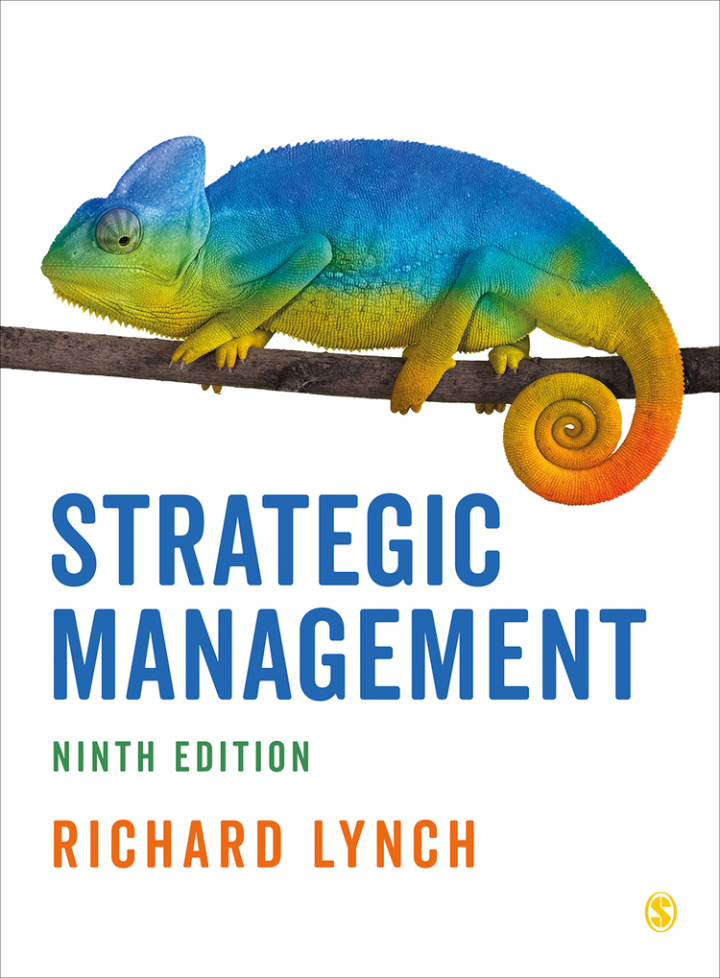
Strategic Management 9th Edition
PUBLISHER: Sage
Trường ĐH, Nhóm, Thư Viện: Gọi 0915920514 để báo giá eBook hosting trên Vital Source hoặc mua Sách In
Quản lý chiến lượcPhiên bản thứ 9 của cuốn sách giáo khoa cốt lõi toàn diện này được xây dựng dựa trên quan điểm toàn cầu và phong cách viết dễ tiếp cận, vì nó khám phá các khái niệm chính trong một cấu trúc rõ ràng và hợp lý. Lynch hướng dẫn bạn qua 19 chương, với các nghiên cứu điển hình và phương pháp sư phạm cập nhật nhằm hỗ trợ sinh viên quản lý và kinh doanh hiện đại từ đầu đến cuối. Sự tương phản liên tục giữa các quan điểm mang tính quy định và mới nổi về chiến lược làm nổi bật các cuộc tranh luận chính trong chuyên ngành, đồng thời nhấn mạnh vào tính thực tiễn xuyên suốt cuốn sách giúp bạn biến lý thuyết thành thực tiễn
List of case studiesAbout the authorAbout the Ninth EditionHow to use this bookGuided tourOnline resourcesTips on writing up strategic projectsPart 1 Introduction1 Strategic management1.1 What is strategic management?1.2 The main topics covered in strategy1.3 Core areas of strategic management1.4 Context, content and process1.5 Process: linking the three core areas2 A review of theory and practice2.1 The importance of strategy context2.2 Prescriptive strategic management in theory and practice2.3 Emergent strategic management in theory and practice2.4 Some prescriptive theories of strategic management2.5 Some emergent theories of strategic managementPart 2 Strategic analysis and purpose3 Analysing the strategic environment3.1 Exploring the competitive environment3.2 Strategic environment – the basics3.3 Degree of turbulence in the environment3.4 Analysing the general environment3.5 Analysing the stages of market growth3.6 Key factors for success in an industry3.7 Analysing the competitive industry environment – the contribution of Porter3.8 Analysing the co-operative environment3.9 Analysing one or more immediate competitors in depth3.10 Analysing the customer and market segmentation4 Analysing resources and capabilities4.1 Analysing resources and capabilities4.2 Why does an organisation possess any resources at all? The make-or-buy decision4.3 Resource analysis and adding value4.4 Adding value: the value chain and the value system – the contribution of Porter4.5 Resource analysis and competitive advantage – the resource-based view (RBV)4.6 Identifying which resources and capabilities deliver sustainable competitive advantage4.7 Analysing other important company resources: especially human resources5 Strategy dynamics5.1 Dynamics of previous history5.2 Dynamic capabilities5.3 Upgrading capabilities: how to improve competitive advantage5.4 The dynamics of an organisation’s changing and uncertain environment5.5 Competitive warfare dynamics5.6 Uncertainty-based strategic dynamics6 Prescriptive purpose delivered through mission, objectives and ethics6.1 Shaping the purpose of the organisation6.2 The purpose of the organisation: shareholders, stakeholders and ‘above average returns’6.3 Developing a strategic vision for the future6.4 Stakeholder power analysis6.5 Corporate governance and the purpose of the organisation6.6 Purpose shaped by ethics and Corporate Social Responsibility6.7 Developing the mission6.8 Developing the objectives7 Purpose emerging from innovation, new resources and technologies7.1 The benefits and problems of innovation7.2 Sources of innovation: market pull and technology push7.3 Blue Ocean innovation: the contribution of Kim and Mauborgne7.4 How to innovate: the ‘ideas’ process7.5 Paradigm shifts in new resources and technology7.6 General technology standards7.7 New resource developmentPart 3 Developing the strategy8 Developing business-level strategy options8.1 Purpose and the SWOT analysis – the contribution of Andrews8.2 Environment-based options: generic strategies – the contribution of Porter8.3 Environment-based strategic options: the market options matrix8.4 Environment-based strategic options: the expansion method matrix8.5 Resource-based strategic options: the resource-based view8.6 Resource-based strategic options: cost reduction9 Developing corporate-level strategy options9.1 Corporate-level strategy: the benefits and costs of diversifying9.2 Corporate options: degrees of diversification9.3 Corporate strategy and the role of the centre – the principle of parenting9.4 Corporate strategy: decisions about the company’s diversified portfolio of products9.5 The tools of corporate-level options: from acquisitions to restructuring10 Strategy evaluation and development: the prescriptive process10.1 Prescriptive strategy content: evaluation against six criteria10.2 Strategy evaluation: procedures and techniques10.3 Applying empirical evidence and guidelines10.4 The classic prescriptive model of strategic management: exploring the process11 Finding the strategic route forward from knowledge, learning and networks11.1 Knowledge-based strategy11.2 Learning-based strategy11.3 Network-based strategy11.4 Co-operation-based strategies12 Organisational structure, style and people issues12.1 Strategy before structure?12.2 Building the organisation’s structure: basic principles12.3 The choice of management style and culture12.4 Types of organisational structure12.5 Organisational structures for innovation12.6 Motivation and staffing in strategy implementationPart 4 The implementation process13 Implementing and controlling the strategic plan13.1 The nature and limitations of the implementation process13.2 Objectives, task setting and communicating the strategy13.3 Resource allocation13.4 Information, monitoring and control13.5 The Balanced Scorecard: the contribution of Kaplan and Norton13.6 Prescriptive strategic planning13.7 What is a business model?14 Green strategy and sustainability14.1 Green strategy and sustainability: the main topics14.2 Green strategy: environmental analysis14.3 Green strategy: analysing resources and capabilities14.4 Green strategy: stakeholders and organisational purpose14.5 Green strategy: knowledge, technology and innovation14.6 Green strategy: strategic options and choice14.7 Implementing green strategies15 Managing strategic change15.1 The basic concept of strategic change15.2 Analysing the causes of strategic change15.3 Prescriptive approaches to managing strategic change15.4 Emergent approaches to managing change15.5 Developing a strategic change programmePart 5 Different strategy contexts16 Strategic leadership16.1 What is strategic leadership?16.2 What makes a successful leader?16.3 How leadership roles change over time16.4 How leaders cope with power16.5 Successful strategic leadership17 Entrepreneurial strategy17.1 Entrepreneurial strategy: theory and practice17.2 Entrepreneurial strategy: personal aspects and risk taking17.3 The four drivers of entrepreneurial strategy: imagination, ideas, invention and innovation17.4 Entrepreneurial strategy: competitive advantage and ownership17.5 Implementing entrepreneurial strategy18 Government, public sector and not-for-profit strategies18.1 Analysing the strategic environment in public sector strategy18.2 Analysing resources in the public and not-for-profit sectors18.3 Exploring the purpose of public and not-for-profit organisations18.4 Context, content and process in public sector strategy18.5 Implementation in public sector strategy19 International expansion and globalisation strategies19.1 International expansion and globalisation: their meaning and importance19.2 World trade and the international expansion theories19.3 Influence of institutions involved in international trade19.4 International and global expansion: the company perspective19.5 Developing international relationships such as alliances and joint venturesGlossaryIndex















